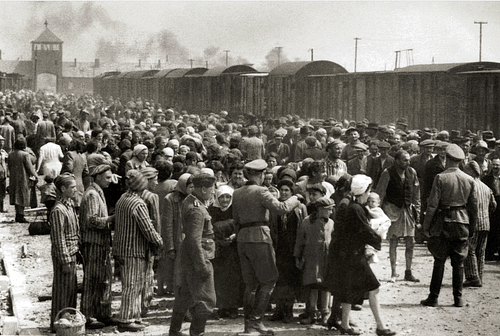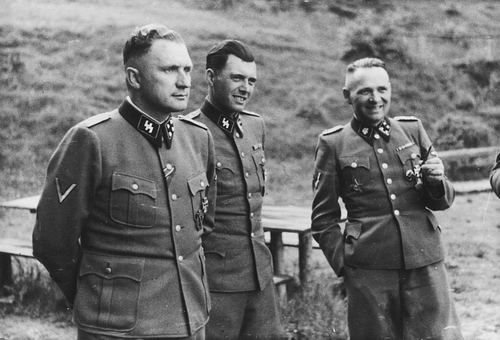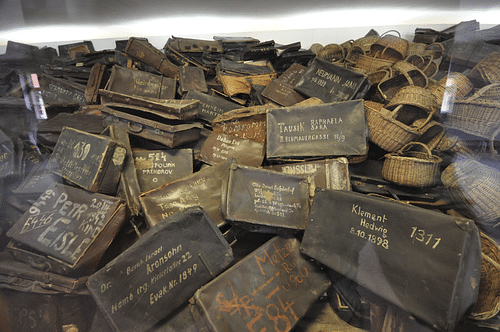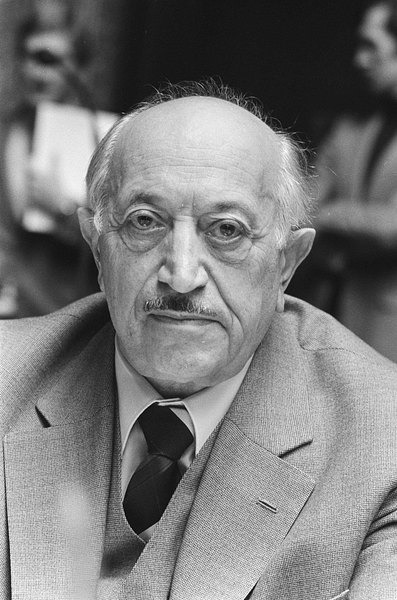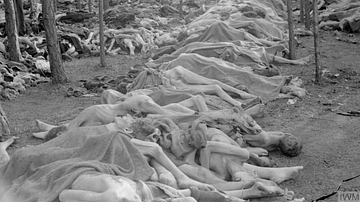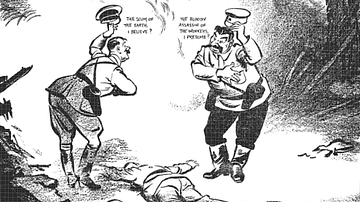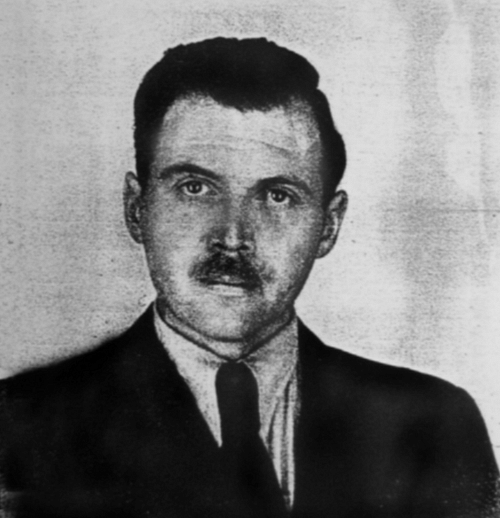
Josef Mengele (1911-1979) was a Nazi doctor who performed horrific pseudo-scientific experiments on detainees in the Auschwitz concentration camp where he was a medical officer from 1943 to 1945. Thousands of Mengele's victims endured bizarre and unnecessary operations without anaesthetic, and the 'Angel of Death', as he was known, killed thousands more using lethal injections.
Mengele literally had the power of life and death over the inmates of the Auschwitz complex, specifically at the Birkenau camp. Obsessed with genetics and creating a master race, it is important to note regarding Mengele's experiments on humans, "that very little, if any benefit to science was achieved" (Shirer, 979). Mengele escaped identification immediately after the war, but as awareness grew of his crimes, he fled to South America where, although obliged to move countries several times, he managed to escape justice. Mengele's remains were exhumed and identified in 1985; he had died of natural causes in 1979.
Early Life
Josef Mengele was born on 16 March 1911 in Günzburg, Germany. Josef's father, Karl, owned a factory producing agricultural machinery. The factory was a success and curiously, given later events, there was a branch in Argentina. Josef studied philosophy in Munich and then took a medical degree at the University of Frankfurt. He joined the fascist National Socialist German Workers' Party (NSDAP), or Nazi Party for short, in 1937. Mengele worked in the Nazi Institute of Hereditary Biology and Race Research and further developed his interest in racial theory by studying the works of such Nazi ideologists as Alfred Rosenberg (1893-1946). When the Second World War (1939-45) began, Dr Mengele joined the Waffen-SS and became a medical officer. He served on both the Western and Eastern Fronts – winning two Iron Cross medals – but also continued his research into race theory and particularly genetics. In 1943, Heinrich Himmler (1900-1945), head of the SS, appointed Mengele to the staff of the most notorious of all Nazi concentration camps: Auschwitz.
The 'Angel of Death'
The complex of Nazi concentration camps which are usually referred to collectively as Auschwitz are located in German-occupied Poland and then consisted of three main camps. Victims were used as forced labour or executed in gas chambers (or both) and then collectively cremated. Auschwitz thus became a major part of the Nazis' Final Solution, that is the deliberate execution of all European Jews, a tragedy of humanity widely known today as the Holocaust. Jewish people made up the majority of the victims, but other significant groups targeted by the Nazis included Romani people, people with physical and mental disabilities, intellectuals, Communists, prisoners of war, partisans, Freemasons, and anyone who had spoken out against the reign of terror led by Adolf Hitler (1889-1945).
Mengele first served as deputy to the Birkenau death camp's chief medical officer, Dr Hans Klein, but when Klein moved on to the Bergen-Belsen concentration camp in northern Germany, Mengele took over his position. The Nazi concentration camp network included some 200 sadistic medical practitioners, all conducting bizarre and horrific experiments on living humans for dubious benefit to science. Of these devils in white coats, Mengele was to become one of the most notorious.
When he took over from Klein, Mengele set about conducting a series of pseudo-medical experiments on anyone he saw fit to. Mengele had the absolute power of life and death over those he chose to experiment upon. He selected from new Jewish camp arrivals who would work as labourers, who would be sent to the gas chambers, and who (men, women, and children) he would like to experiment on, thus saving their lives for the moment but condemning them to, in many cases, a fate worse than death. The sinister doctor's habit of always wearing an immaculate white coat (sometimes with matching gloves) and spreading out his arms and whistling while choosing his next victims led to the inmates of Auschwitz calling Mengele the 'White Angel' and 'Angel of Death'. Mengele could be charming, smiling, and even understanding as he directed the prisoners to the left or the right, one direction led to the labour camps and the other to the gas chambers. He also played games with his victims, but these were only for his own satisfaction such as switching the destination queues or making cryptic comments to a passing victim as to what was really about to happen to them. He would whistle music and ask a victim to identify it; if they failed, off they went to the direction that led to immediate death.
Mengele was, then, far from being a doctor who distanced himself from the killing. A former colleague commented that Mengele was "a man who believed in nothing but power, the ultimate cynic" (Levy, 355). Mengele positively revelled in his diabolical work. As the historian Al Cimino notes:
On one occasion a mother did not want to be separated from her 13-year-old daughter, so she bit and scratched the face of the SS man who tried to force her to her assigned line. Mengele drew his gun and shot both the woman and the child.
As a blanket punishment he sent everyone to be gassed, including those who had been selected for work, with the comment: 'Away with this shit!'
(222)
In another example of Mengele's crimes unrelated to medical experiments, he once had the entire occupants of a hut, around 750 women, immediately sent to the gas chambers because he was informed the hut was infested with lice.
Mengele's Experiments
Mengele was particularly fascinated by the idea of promoting the birth of twins, something he thought could boost the population of the Third Reich. Mengele delivered countless babies born in the camps, almost always, unless there were twins or the baby had an interesting physical defect he could study, afterwards promptly sending mother and child to immediate death in the gas chambers. Another area of interest was genetics as Mengele hoped to create the blonde and blue-eyed Nazi super race, which he, like so many other Nazis, was not actually a member of.
Mengele's "experiments" included administering various sorts of lethal injection. Some injections were to give the victim a fatal disease, and so their symptoms and death struggle could be observed. Children were put in cages and left in isolation to study their reactions. Mengele frequently injected one twin with the blood of their twin but which was a different blood type. Twins were castrated or sterilized. He once had two Romani children sewn together in order to artificially create Siamese twins. The evil doctor frequently removed a limb or organ from a victim, usually without anaesthetic. He performed dissections while the victim was still alive. He injected blue dye into victims' eyes, which often resulted in them going blind. Mengele then had the patient killed and attached their eyes to the walls of his office like butterflies, creating a gruesome spectrum of colours from pale yellow to piercing violet. Mengele operated without any restrictions on his activities whatsoever, but amongst all of these horrors, the doctor was known for his pleasant and polite manner; he even gave sweets to children in the camp.
One prisoner, the Polish anthropologist Dr Martina Puznya, was forced to work with Mengele, and she recorded her views on the doctor's complete lack of proper scientific method:
[He can] only be described as a maniac…Above all, I believe that he was doing this for himself, for his career. In the end, I believed he would have killed his own mother if it would have helped him…His experiments were carried out in an abnormal fashion…Mengele had no one to account to but himself. He did whatever pleased him and conducted his experiments like a mad amateur. He was not a savant. He had the mania of a collector.
(Levy, 243 & 245).
Escape
Auschwitz was liberated by the USSR's Red Army in January 1945. The Nazis had already begun the demolition of their terrible machine of destruction, but enough remained to confirm what had been going on there. Eyewitness accounts from survivors filled out the terrifying details. It is estimated that between 1.2 and 1.5 million people died at Auschwitz. The number of Jewish people who were murdered there was around 800,000.
At the close of WWII, Mengele escaped justice but did so in plain sight. The Nazi doctor benefitted from not having the usual SS officer's tattoo, and he was not widely known since he had avoided being photographed throughout his time in the SS. After he was checked and processed by the Allied authorities, Mengele was given papers under his assumed name of Fritz Hollmann. Mengele was able to live for the next three years as a farmhand in Bavaria. He was helped by old friends, and from the summer of 1948 to the spring of 1949, Mengele even lived in hiding in his hometown of Günzburg.
The victorious Allies did conduct a series of trials specifically against Nazis who had conducted medical experiments on innocent people. The Doctor Trials (1946-7), as they became known, brought to justice 23 doctors, including such notorious figures as Karl Gebhardt (1897-1948), who was hanged, and Fritz Fischer (1912-2003), who was given 20 years imprisonment (but released in 1954). Many of the defendants were incriminated not only through the testimony of 85 witnesses but also by their own, often meticulous, written records of their experiments. In total, 16 doctors were found guilty of crimes against humanity and seven received the death sentence.
The Doctor Trials raised public awareness, and as Mengele's name now kept cropping up in relation to war crimes, he fled Europe for the safety of Argentina in July 1949. Mengele was helped in his escape by a well-established network of Nazis and Nazi sympathisers, which included senior members of the Catholic Church and figures in the Argentine government. In addition, this network very likely supported Mengele financially during his years on the run.
A Hunted Man
Once established in Buenos Aires, Mengele began to practise medicine again, although he felt it prudent to change his false identity several times. Mengele lived well since the company his father had founded was still going strong and could now divert funds to him (although this was repeatedly denied by the firm and family back in Germany). Mengele was even able to use his own name again and create a new company specialising in pharmaceuticals.
In 1958, Mengele began to explore a permanent move to Paraguay where there was a sympathetic fascist government. In 1959, the West German government gave proof to the Argentine authorities that Mengele was on their territory and called for his extradition, but the response was that Mengele's crimes were considered only "political" and so the matter would require a lengthy investigation. Mengele made his move, and thanks to help from ex-Nazis, he became a citizen of Paraguay in 1959. The government of Paraguay, like that in Argentina, was sympathetic to fugitives from Nazi Germany and repeatedly denied Mengele was living there. Crucially, the country also had a law that prohibited extradition of Paraguayan citizens.
Mengele remained one of the most sought-after Nazi war criminals – the West German government was now offering a substantial cash reward for his capture – and so, around 1961, he moved again, this time to Brazil. Most people concerned with trying to catch Mengele were, however, convinced he was still in Paraguay. Mengele must have seen with dismay the capture, trial, and subsequent hanging of Adolf Eichmann (1906-1962), another notorious Nazi fugitive, by the Israeli government in 1962. Certainly, Mossad, the Israeli intelligence service, was actively searching for Mengele and was prepared to kidnap him, wherever he was, for trial in Israel. Other parties interested in apprehending the fugitive included Nazi-hunters like Simon Wiesenthal (1908-2005) and Beate Klarsfeld (b. 1939).
In 1963, the West German government, still convinced Mengele was in hiding in Paraguay, offered the country's dictator Alfredo Stroessner (l. 1912-2006) a huge cash incentive to hand over the doctor, but the offer was declined. What Stroessner did not say was that Mengele was no longer in Paraguay. Mengele was repeatedly assisted by ex-Nazis and Nazi sympathisers, many of whom had official connections. The fugitive doctor, we now know, was living in Brazil from the early 1960s and working as a farm manager under a new false identity. Mengele's employers knew who he really was, but were paid to keep quiet by Nazi sympathisers, and they received cash from Mengele himself to fund their business. Meanwhile, in the wider world, a series of false sightings in various countries resulted in nothing more than the cash reward for Mengele's capture quadrupling.
Death Confirmed
Finally, a breakthrough in the hunt for Mengele came. A news report in January 1985 suggested Mengele was still in Paraguay, but in June of that year, another report claimed that he had drowned in Brazil back in 1979 after suffering a stroke while swimming. The story of Mengele's death on 7 February at Bertioga near São Paolo was investigated by the authorities, a coffin was exhumed, and the human remains tested by a team of 16 international forensic experts. The conclusion of the experts based on genetic testing and a later comparison with dental records was that the body in the coffin was, as certainly as science could prove, that of Josef Mengele. Further DNA testing in 1992 confirmed this original conclusion.
The question of what exactly Mengele had got up to while he was in South America has been a source of much speculation, most of it wildly inaccurate when, in reality, Mengele lived a quiet, restricted, and probably unbearably tedious existence in his final two decades. The village of Cândido Godói in Brazil, for example, which Mengele visited, displayed an unusually high number of twin births, and so speculation was rife that Mengele was busily continuing his Auschwitz experiments later in life. However, Brazilian scientists have discounted this connection as a myth and point to the fact that the twins phenomenon was already present before Mengele ever visited. Nevertheless, such speculation and others like it display, perhaps, a lasting mix of fascination, revulsion, and frustration that one of the most notorious of all Nazi criminals was never brought to justice.
